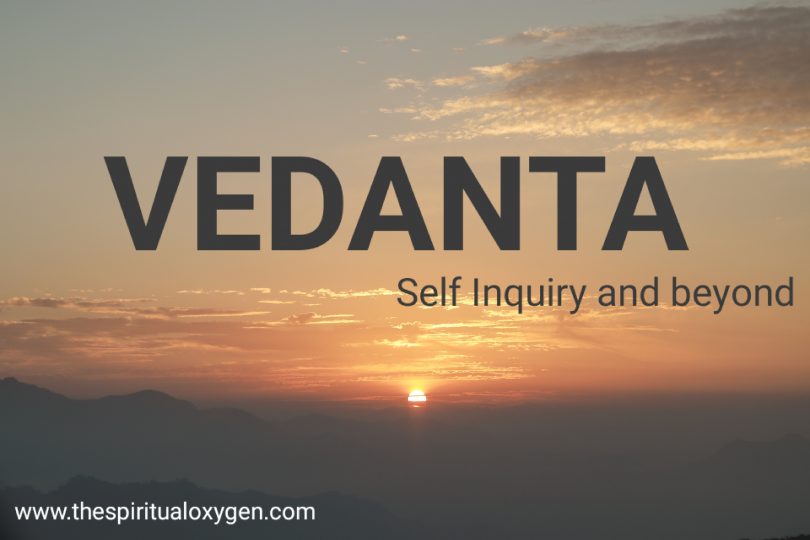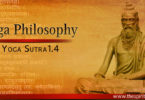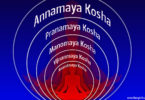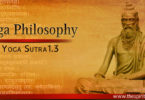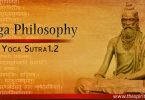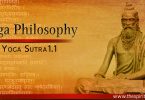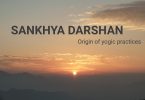Vedanta is one of the world’s most ancient spiritual philosophies. In India philosophy known as Darsana. There are six schools of philosophy and Vedanta is one of them. The other five philosophical schools are Sankhya, Yoga, Nyaya, Vaisheshika, Meemaamsa.
What is Vedanta?
The word “Vedanta” is a combination of two words- ‘veda’ and ‘anata’. ‘Veda’ means ‘knowledge’ and ‘anta’ means ‘the end’ or ‘conclusion’.
In this context knowledge is not just about reading some books but the knowledge of our true self and beyond. It is about self inquiry so that we can manifest our own divinity.
Vedanta is the part of Veda. Veda is oldest text available to us and considered as highest authority of knowledge. Veda serves as base of all the available system of knowledge. The Vedas are comprised of 4 major books. Let’s look at them briefly.
Also read about Sankhya Darshan.
The four Vedas
- Rig Veda – It is one the oldest form them. Known as book of mantra.
- Saam Veda – It is referred as the book of Chant and is comprised of text primarily from the Rig Veda, set to various melodies. Indian classical music and dance have their roots in the Sama Veda.
- Yajur Veda – It can be referred as book of ritual which gives instructions to perform various rituals to gain benefits and well-being.
- Atharva veda – It can be referred as book of spells and medical science. Ayurveda is the upveda of Atharva veda.
Origin of Vedanta
It is really heavy task to find origin of Vedanta. But we know Vedanta is conclusion of Vedas and as well oldest literature of Indian knowledge. The Upanishads, the Bhagavad Gita and the Brahma Sutras constitute the basis of Vedanta. All the schools of Vedanta philosophy has evolved through commentaries on these texts. Each Veda has four sections. Thse four sections are
- Samhita – which are a collection of hymns and prayers
- Brahmana – it discusses the mystic significance and knowledge of sacred ceremonies so that the intended results may be achieved. Brahmanas are commentaries on Samhita.
- Aranyaka – They are intended for those who have withdrawn from ordinary daily life. Also provides deeper interpretation of the sacred ceremonies. Aranyakas often has referred as text of forest.
- Upanishada – it is the most popular part of Vedas. Upanishads are philosophical speculations on nature of soul, ultimate reality and liberation. They suggest us the path for our spiritual journey so that we can manifest our own divinity.
In one way Vedanta means philosophical system originated from Upnisada, as Upanishada are last part of veda. In another way, it means the ‘conclusion of vedas’.
The Vedanta philosophy was available in Upanisada but in scattered form. It was systematized in the form of formulas called Brahama Sutras. Sutra is a method of writing in ‘short statement’ so their explanation through commentaries was needed. Later different Scholars made their commentaries on Upanishads, the Bhagavad Gita and the Brahma Sutras, which gave rise to different schools of Vedanta.
Also read about Yoga Sutrs of Patanajali.
Although these different schools explain relation between individual souls called Atman, Ultimate Reality called Brahman and world differently.
Here are three different types of Vedanta
- Advaita – known as philosophy of non-dualism and propounded by Adi Shankaracharya. It regards world as illusion, and individual souls as identical to Brahamn.
- Vishista-advait – known as qualified non-dualism and propounded by Ramanuja. It regards world as real, and considers world and individual souls as part of Brahamn.
- Dvaita – known as philosophy of dualism, propounded by Madhva, can be described as dualism. It makes distinction between two types of realities, Independent reality and dependent reality. Brahman is independent reality, while individual souls and world are dependent on Brahaman. Therefore, they are dependent realities.
The Core Teachings of Vedanta
- Brahman is the ultimate reality, beyond duality, beyond space and time, name and form, without beginning or end.
- All duality is product of mind. Thus the universe is an illusion which constantly changing. This illusion disappears in the light of self knowledge.
- Brahman is all that is manifested or un-manifested. Self and non self both originates from Brahman.
- The real nature of human being is Atman, which is infinite, pure, and eternal.
- Karma (selfless service), Gyana (knowledge of the Self), Bhakti (love and devotion), and Raja (techniques such as meditation) are four ways to recognize Atman (inner self).
- Truth is universal and can’t be limited by race, religion, or personal choice. It may be expressed in different ways. All ultimately lead to the same truth.

